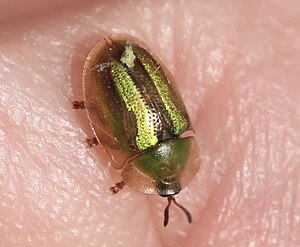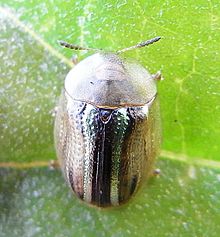Gold-striped shield beetle
| Gold-striped shield beetle | ||||||||||||
|---|---|---|---|---|---|---|---|---|---|---|---|---|

Gold-striped tortoise beetle ( Cassida nobilis ) |
||||||||||||
| Systematics | ||||||||||||
|
||||||||||||
| Scientific name | ||||||||||||
| Cassida nobilis | ||||||||||||
| ( Linnaeus , 1758) |
The gold-striped shield beetle ( Cassida nobilis ) is a beetle from the leaf beetle family and the shield beetle subfamily . Of the eleven subgenus of the genus Cassida , the species Cassida nobilis is assigned to the subgenus Casidulella .
The scientific genus name Cassida is from Altgr. κασίδιον, κάσσις kasidion, kássis , "helmet, shield" derived, and refers to the pronotum , which characteristically covers the head like a shield. The species name nobilis ( lat. ) Means "noble" and probably alludes to the longitudinal stripes that shine like mother-of-pearl on each wing cover. The species is widespread in Europe.
Characteristics of the beetle
The body reaches a length of 4 to 4.5 millimeters. It is hairless and oval in shape. The sides of the elytra and the front edge of the pronotum are drawn down in such a way that the pronotum and the elytra together arch like a bell over the body and head.
On the underside of the pronotum there is no distinct furrow next to the head into which the antennae could be inserted. If you look at the front of the head, you can see two deep lines on the forehead that converge and meet about halfway up the eyes, well before the antennae deflect. The eleven-limbed antennae arise close together between the eyes. They are thread-like and thicken outwards to form a loose, darkened club.
The pronotum is large, shallowly dotted, its front edge roughly semicircular and the rear corners rounded.
The elytra have clear dot stripes , which are disturbed by adjacent dots, especially between the third and fourth stripes. The spaces between the rows of dots are hairless. Like the pronotum, the elytra are yellow-brown to red-brown in color, the first two spaces are more often darker, the third somewhat wider and, in life, with a pearlescent sheen. In the middle area of the wing covers, the sides drop steeply and are not flattened in the edge area. The label is clearly visible.
The legs are reminiscent of those of the ladybug . The tarsal links are short and wide and strongly nested, the penultimate (third) deeply split. The imperforate claws protrude only a little beyond the lobes of the third tarsal phalanx, but are not, as in other species of the genus, protruded from the lobes' tips. The thighs are black to the middle, the tip of the thigh, rails and tarsi are yellow.
biology
The species can be found on various foxtail plants and various carnation plants , for example on the cultivated beet or by the sea on the chickweed . On the beet, the larvae cause speckled, pin-head-sized feeding sites on the leaf. The damage to plants at the edge of the field is greater and skeletal damage is also possible.
distribution
The species is distributed in the Palearctic from the west coast of Europe to Japan. In Europe it occurs from the Mediterranean Sea to the Arctic Circle .
literature
- Heinz joy, Karl Wilhelm Harde, Gustav Adolf Lohse (ed.): The beetles of Central Europe . tape 9 . Cerambycidae Chrysomelidae . Spektrum Akademischer Verlag, Munich 1999, ISBN 3-8274-0683-8 (first edition: Goecke & Evers, Krefeld 1966).
- Gustav Jäger (Ed.): CG Calwer’s Käferbuch . K. Thienemanns, Stuttgart 1876, 3rd edition
Individual evidence
- ↑ a b Cassida (Cassidulella) nobilis at fauna Europaea. Retrieved January 28, 2011
- ↑ "Explanation of the scientific beetle names"
- ^ Agricultural service: beet pests
- ↑ Polish koleopterologische site


